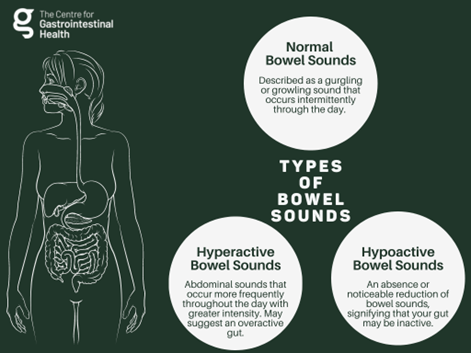A nurse is reinforcing teaching to a newly licensed nurse about bowel sounds. Which of the following characteristics should the nurse use to describe hyperactive bowel sounds?
Sounds are high-pitched
Can be a result of a paralytic ileus
Indicates decreased motility
Sounds are soft and at a rate of 1/min
The Correct Answer is A
Hyperactive bowel sounds are bowel sounds that are louder and more frequent than normal. They may be heard as high-pitched rushing or tinkling sounds that occur irregularly at a rate greater than 5-6 sounds per minute. They are often associated with increased intestinal motility, such as diarrhea, gastroenteritis, or early bowel obstruction.
Option b is incorrect because hyperactive bowel sounds are not typically associated with a paralytic ileus, which is a condition where the bowel stops working and there is a lack of bowel sounds.
Option c is incorrect because hyperactive bowel sounds indicate increased motility, not decreased motility.
Option d is incorrect because soft bowel sounds at a rate of 1/min are considered hypoactive bowel sounds, which can be a sign of decreased intestinal motility, as seen in constipation or postoperative ileus.

Nursing Test Bank
Naxlex Comprehensive Predictor Exams
Related Questions
Correct Answer is A
Explanation
This statement should be included in the change-of-shift report because it provides vital information about the patient’s condition and any changes that have occurred to the patient during the shift.
Statement B is wrong because it does not provide relevant information about the patient’s current condition or changes that have occurred during the shift. Statement C is wrong because it does not provide relevant information about the patient’s medical condition. Statement D is wrong because it does not provide new information about changes that have occurred during the shift.
Change-of-shift reports are key to inpatient care because they provide vital information about and responsibility for the patient from the off-going provider to the on-coming provider.
Correct Answer is D
Explanation
Oxytocin is a medication commonly used to induce or enhance uterine contractions. Therefore, it is expected that the client may experience uterine cramping after receiving oxytocin. The medication helps to contract the uterus, which can aid in controlling excessive vaginal bleeding.

Whether you are a student looking to ace your exams or a practicing nurse seeking to enhance your expertise , our nursing education contents will empower you with the confidence and competence to make a difference in the lives of patients and become a respected leader in the healthcare field.
Visit Naxlex, invest in your future and unlock endless possibilities with our unparalleled nursing education contents today
Report Wrong Answer on the Current Question
Do you disagree with the answer? If yes, what is your expected answer? Explain.
Kindly be descriptive with the issue you are facing.
